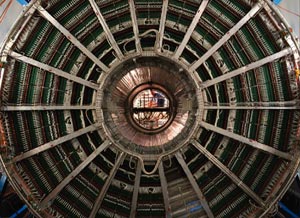On 16 June the time projection chamber (TPC) for the ALICE experiment at the Large Hadron Collider (LHC) started to record its first real events, reconstructing the tracks of cosmic rays. ALICE will search for evidence for quark-gluon plasma in head-on collisions of lead ions at the LHC. This requires precise tracking to record the paths of thousands of particles produced in the collisions. ALICE is therefore built around the largest TPC in the world. Based on a cylindrical field cage 5 m long and 5 m in diameter, the TPC is now nearing completion, with all the read-out chambers installed and the custom electronics complete for the approximately 560,000 read-out channels.

The TPC consists of a field cage made of carbon-fibre composites, which contains the central high-voltage electrode and four potential-divider chains to create a uniform electric drift field in the active volume of 95 m3, filled with a mixture of Ne, CO2 and N2. The high-voltage electrode is run at 100 kV and shielded to the outside by containment vessels filled with CO2 gas. The detector is now running stably at 100 kV with the final gas mixture.

The TPC read-out system on the aluminium endplates is partitioned into 18 sectors on each side. Each sector comprises an inner (small) and outer (large) trapezoidal read-out chamber based on multiwire proportional chambers with pad read-out. The signals from the pads are passed via flexible Kapton cables to 4356 front-end cards located some 10 cm away from the pad plane. In the front-end cards, the signals are amplified, converted to digital format, and then pre-processed by a specially designed combination of read-out chips. With the ultra-low power consumption of its electronics (<45 mW/channel), the whole TPC requires about 25 kW of electrical power for full operation. However, only a fraction of the power and of the corresponding water-cooling plant is available in the clean room, so commissioning is proceeding with two sectors at a time.
The tests use the ALICE cosmic muon trigger detector ACORDE, as well as a specially designed UV laser system, to produce tracks in the detector. Preliminary analysis of the cosmic-ray events and the laser-induced tracks indicate that the drift velocity and diffusion of electrons liberated by traversing charged particles, as well as the spatial resolution, are very close to the design values. Commissioning, during which every one of the 36 sectors will be turned on and its performance studied, will last until October. The TPC will then be transferred into the ALICE underground area prior to installation and final connection of all services ready for first collisions in November 2007.





